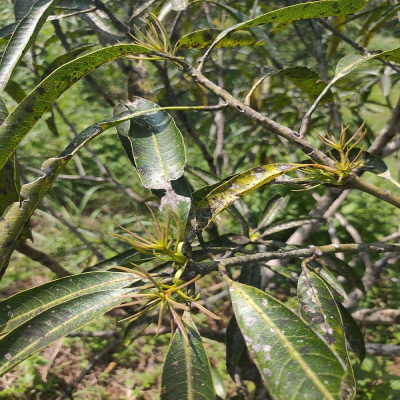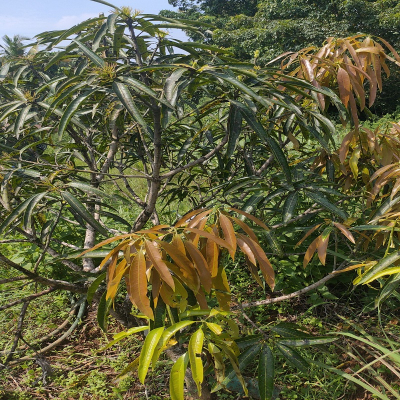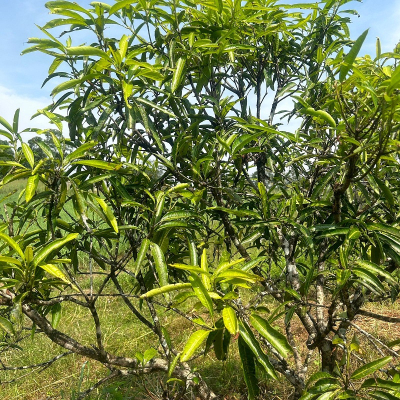Mangifera indica Linn.
Family : Anacardiaceae
Group : 6. Star trees
Parts Used : Root , Fruit , Leaf , Seed , Bark
Vernacular Names :-
| English | : | Mango tree, Cuckoo’s joy |
| Malayalam | : | Mavu |
| Hindi | : | Amb |
| Sanskrit | : | Amrah |
| Assamese | : | Ghariam |
| Bengali | : | Am |
| Gujarathi | : | Amri |
| Kannada | : | Mavu |
| Tamil | : | Mamaram |
| Telungu | : | Mamidi |
Distribution and Habitat: Found throughout tropics
Botany: It is a large evergreen tree, 10-45 m high with deep tap root system.
- Leaf: The leaves are simple, linear- oblong or elliptic-lanceolate, 10-30 cm long, petiolate, alternate, irregularly placed along the branchlets.
- Flowers: Small, reddish white or yellowish green, in large panicles.
- Fruits: Variable in form and size, green, yellowish or red, fleshy. Seeds solitary, ovoid-oblique, engaged in a hard fibrous endocarp.
Properties:
- The root and bark are acrid, cooling and astringent.
- Flowers are cooling and astringent.
- Unripe fruit is acrid, acid, astringent, tasty, stomachic and antiscorbutic.
- Ripe fruit is laxative, nourishing, and invigourating, diuretic, astringent, diaphoretic and refrigerant.
- Bark astringent.
Chemical constituents:
- Leaves contains two flavonoids, two phenolic compounds, carbohydrates and tannin.
- Panicles give ethyl acetate.
- Mangiferin has been isolated from bark.
- Roots give mangiferin, friedelin, and β-sitosterol.
- Fruits contain vitamins A, C, and D.
Uses:
- Bark is used in utrine haemorrhages, diarrhoea, in diphtheria, Rheumatism.
- The extract of leaves, bark and stems and unripe fruit exhibit moderate anti-bacterial activity.
- Mangiferin has cardiotonic and diuretic properties
Formulations: Pshyanuga churna, amrapanaka, khandabhrakam, vridhagangadhara churna, jatiphala rasa, jambavadi kvatha, mehamihira taila, ashokarishta, madhukadyabaleha, chandanadi churna
Agro technology
Climate and soil: Mango is adaptable to a wide range of climate and soil conditions and grows well from sea level up to about 1500 m. It withstands both fairly dry conditions and high rainfall.
Propagation: It is propagated from seed and by grafting. Inarching or simple approach grafting is the method commonly practised in India.
Irrigation: Irrigate twice a week during summer months till the plant are 4-5 years old.
Manures and fertilizers: Apply organic manures in May-June with the onset of monsoon. Apply the fertilizers in one dose during May-June until bearing stage and there after in two equal split doses.
Plant protection: The important pests are hoppers, stem borers, shoot midges, leaf feeding insects, fruit flies and psyllids. The common diseases are the powdery mildew and anthracnose and dieback. Spraying Guesarol containing 5% DDT and 50% sulphur gives good result in controlling both mildew and jassid hoppers.





